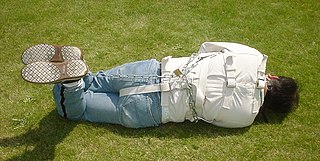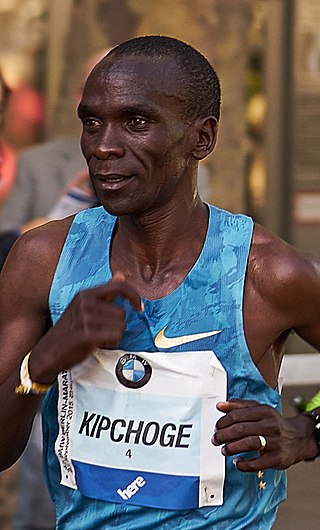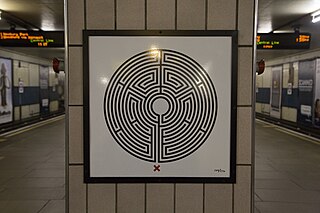
Guinness World Records, known from its inception in 1955 until 1999 as The Guinness Book of Records and in previous United States editions as The Guinness Book of World Records, is a British reference book published annually, listing world records both of human achievements and the extremes of the natural world. The brainchild of Sir Hugh Beaver, the book was co-founded by twin brothers Norris and Ross McWhirter in Fleet Street, London, in August 1955.

Keepie uppie, keep-ups or kick-ups is the skill of juggling with an association football using feet, lower legs, knees, chest, shoulders, and head, without allowing the ball to hit the ground. It is similar to Kemari, a game formerly practiced in the Japanese imperial court.

A straitjacket is a garment shaped like a jacket with long sleeves that surpass the tips of the wearer's fingers. Its most typical use is restraining people who may cause harm to themselves or others. Once the wearer slides their arms into the sleeves, the person restraining the wearer crosses the sleeves against the chest and ties the ends of the sleeves to the back of the jacket, ensuring the arms are close to the chest with as little movement as possible.

An egg-and-spoon race is a sporting event in which participants must balance an egg or similarly shaped item upon a spoon and race with it to the finishing line. At many primary schools an egg-and-spoon race is staged as part of the annual Sports Day, alongside other events such as the sack race and the three-legged race.

Land's End to John o' Groats is the traversal of the length of the island of Great Britain between two extremities, in the southwest and northeast. The traditional distance by road is 874 miles (1,407 km) and takes most cyclists 10 to 14 days; the record for running the route is nine days. Off-road walkers typically walk about 1,200 miles (1,900 km) and take two or three months for the expedition. Signposts indicate the traditional distance at each end.
Gamal Awad was an Egyptian squash player. He was the younger brother of Mohammed Awad another notable Egyptian squash player. Awad became the Egyptian national champion in 1976, and won the British Amateur championship in 1977 and 1978. He finished runner-up to Jahangir Khan at both the 1982 World Masters and the 1983 British Open.

Eliud Kipchoge is a Kenyan long-distance runner who competes in the marathon and formerly specialized at the 5000 metre distance. Regarded as the greatest marathon runner of all time, he is the 2016 and 2020 Olympic marathon champion and the world record holder in the marathon with a time of 2:01:09 set at the 2022 Berlin Marathon. He has run four of the six fastest marathons in history.

Eric James Booker, known professionally as Badlands Booker or BadlandsChugs, is an American competitive eater, rapper and YouTube personality. He holds seven Major League Eating recognized world records, three Guinness World Records, is a three-time Nathan's Lemonade Chugging Contest champion, and competed in the Nathan's Hot Dog Eating Contest every year from 1997 to 2018.

The Subway Challenge entails navigating the entire New York City Subway system in the shortest time possible. This ride is also known as the Rapid Transit Challenge and the Ultimate Ride. The challenge requires competitors to stop at all 472 stations; as of 2023, this record is held by Kate Jones of Switzerland. One competitor held the record for 469 stations, as he had competed before the January 2017 opening of the Second Avenue Subway. Three teams held the Guinness record for 468 stations, as they had competed prior to both the September 2015 opening of the 7 Subway Extension and the January 2017 opening of the Second Avenue Subway, but after Dean Street station was closed in 1995. Records set before 1995 had a varying number of stations.

The motorcycle land-speed record is the fastest speed achieved by a motorcycle on land. It is standardized as the speed over a course of fixed length, averaged over two runs in opposite directions. AMA National Land Speed Records requires 2 passes the same calendar day in opposite directions over a timed mile/kilo while FIM Land Speed World Records require two passes in opposite directions to be over a timed mile/kilo completed within 2 hours. These are special or modified motorcycles, distinct from the fastest production motorcycles. The first official Fédération Internationale de Motocyclisme (FIM) record was set in 1920, when Gene Walker rode an Indian on Daytona Beach at 104.12 mph (167.56 km/h). Since late 2010, the Ack Attack team has held the motorcycle land speed record at 376.36 mph (605.69 km/h).

Doug Pruden of Canada holds or held nine world records in push ups, and holds thirteen Canadian records in push ups.
Paul Henry Allen Lynch was a multiple Guinness World Record holder through the 1980s, and 1990s. Paul was best known for his previous world records in push-ups, and most notably consecutive one-finger push-ups.

The plank is an isometric core strength exercise that involves maintaining a position similar to a push-up for the maximum possible time.
Stephen Peter Woodmore was a British electronics salesman known for his rapid speech articulation, being able to articulate 637 words per minute (wpm), a speed four times faster than the average person. Woodmore was listed by the Guinness Book of World Records as the world's fastest talker, taking the helm from the previous record holder, John Moschitta Jr., in August 1990. Woodmore lost his record in 1995, when Sean Shannon from Canada was able to articulate 655 wpm.

Don Lennox is a Guinness World Record holding Scottish ocean rower. Born in Lanark, Scotland, Lennox worked as an architectural model-maker before returning to school at the age of 30 to qualify in Sports Therapy at the City of Glasgow College. Since then, he has worked in the fitness industry as a personal trainer, professional sports team therapist/trainer, and gym owner/manager. Lennox is an ultra runner and ocean rower.

Carl J. Reese is a multiple Guinness World Record-holding endurance driver and motorcyclist.

Labyrinth is a 2013 artwork by the British artist Mark Wallinger which marks the 150th anniversary of the London Underground.

Tuedon "Tee" Omatsola-Morgan, born 3 April 1973 is a Nigerian ultramaraton runner. She has completed in over 73 marathons and has competed in 2 ultramarathons.

Geoff Marshall is an English video producer, performer, and author from London who runs a YouTube channel which is predominantly transport-themed. Born in London, he spent almost four years living in the United States between 2006 and 2009, and now resides in South London.
















